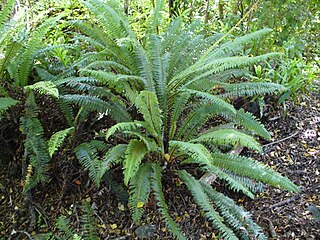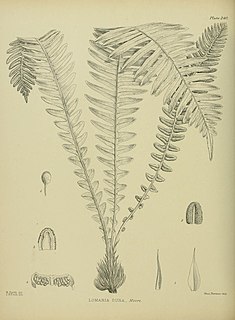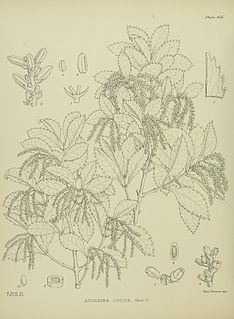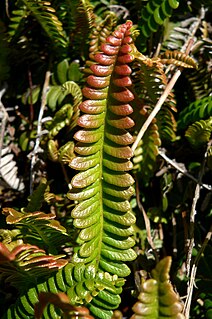
Blechnaceae is a family of ferns in the order Polypodiales, with a cosmopolitan distribution. Its status as a family and the number of genera included have both varied considerably. In the Pteridophyte Phylogeny Group classification of 2016, the family has 24 genera, and excludes genera placed in the separate family Onocleaceae. The family is divided into three subfamilies, including Blechnoideae s.s. Alternatively, the entire family may be treated as the subfamily Blechnoideae s.l. of a very broadly defined family Aspleniaceae, and include genera others place in Onocleaceae.
Water fern is a common name for several plants and may refer to:

This is a list of taxa comprising the flora of the Antipodes Islands. It includes some species known as megaherbs.
Blechnum petiolare is a species of fern in the family Blechnaceae. It is endemic to Ecuador and known only from Bolívar Province. When it was first described in the early 20th century, it was known from Chillanes but this area has been heavily disturbed and the species continues to be threatened.
Austroblechnum divergens, synonyms including Blechnum divergens, Blechnum rimbachii and Blechnum floresii, is a species of fern in the family Blechnaceae.

Cranfillia fluviatilis, synonym Blechnum fluviatile, is a fern known in the Māori language as kiwikiwi. A herbaceous plant, C. fluviatilis is a "hard fern" of the genus Cranfillia in the family Blechnaceae. It was identified by Patrick Brownsey in 1979. Other common names are star fern, creek fern, kawakawa and kiwakiwa.

Lomaria discolor, synonym Blechnum discolor, commonly called crown fern, is a species of fern in the family Blechnaceae. This species is endemic to New Zealand. As noted by C. Michael Hogan, this species is found in a number of forest communities in diverse locations within New Zealand, and is sometimes a dominant understory component.
Austroblechnum leyboldtianum, synonym Blechnum blechnoides, known as iquide in Chilean Spanish, is a fern species endemic to Chile.

Austroblechnum durum, synonym Blechnum durum, is a species of fern in the family Blechnaceae. The fern is endemic to New Zealand.

Ascarina lucida, commonly known as hutu is a species of small tree in the family Chloranthaceae. It is endemic to New Zealand, being common on the West Coast and Nelson regions of the South Island and more rarely found in the North Island. A typical plant association is within the Westland podocarp/broadleaf forests with common understory associates of Blechnum discolor, Pseudowintera colorata, Pseudopanax colensoi and Coprosma lucida. Most genus members are dioecious, producing unisexual male or female flowers on separate plants. Ascarina lucida, the only member of its genus to occur in New Zealand, is monoecious. It will grow to a height of 6m and can have a 30 cm trunk. The leaves which are in opposite pairs are simple, yellowish green in color, have a raised mid rib and are very similar to Laurelia novae-zelandiae. Their margins have prominent teeth which are dark colored at the tips. Ascarina lucida is now nearly extinct in the Taranaki region but was last reported in Oct 1969 at Mt Taranaki, near Pukeiti by Colin Ogle.

Austroblechnum lanceolatum, synonym Blechnum chambersii, is a species of fern within the family Blechnaceae, found in Australia, New Zealand, Samoa and Fiji.

Pseudopanax colensoi is a species of evergreen plant. This species is native to New Zealand. An example occurrence in central Westland podocarp/broadleaf forests includes flora associates such as Cyathea smithii and Dicksonia squarrosa, Rumohra adiantiformis, Ascarina lucida, Pseudowintera colorata and Blechnum discolor. The maximum height of this plant is 5 meters and it is the preferred food of possums.

Rumohra adiantiformis, the leather fern or leatherleaf fern, is a species of fern in the wood fern family Dryopteridaceae. It has a wide distribution, mainly in the tropical Southern Hemisphere.

Austroblechnum penna-marina, synonym Blechnum penna-marina, known as Antarctic hard-fern, alpine water fern and pinque, is a species of fern in the family Blechnaceae, with a natural range from the Araucanía Region to the south and from the coast to the tree line of the Magellanic forests in Chile and adjacent areas of Argentina. It is also found in New Zealand, Australia and some Pacific islands. It is evergreen and grows to 20 cm (8 in).

Austroblechnum patersonii, synonym Blechnum patersonii, is a fern in the family Blechnaceae. It is known as the strap water-fern.

Austroblechnum is a genus of ferns in the family Blechnaceae, subfamily Blechnoideae, according to the Pteridophyte Phylogeny Group classification of 2016. The genus is accepted in a 2016 classification of the family Blechnaceae, but other sources sink it into a very broadly defined Blechnum, equivalent to the whole of the PPG I subfamily.
Austroblechnum lehmannii is a species of fern in the family Blechnaceae. It is native to Mexico, Central America, South America and the Galápagos Islands.

Roaring Billy Falls is a waterfall in Mount Aspiring National Park, Westland District, New Zealand. It is located in the Haast River valley, around 30 km (19 mi) inland from Haast, near Eighteen Mile Bluff on State Highway 6. The falls are a 30-metre-high (98 ft) cascade on The Roaring Billy stream. The bottom of the cascade is at an elevation of around 80 metres (262 ft) where it flows into the Haast River.













